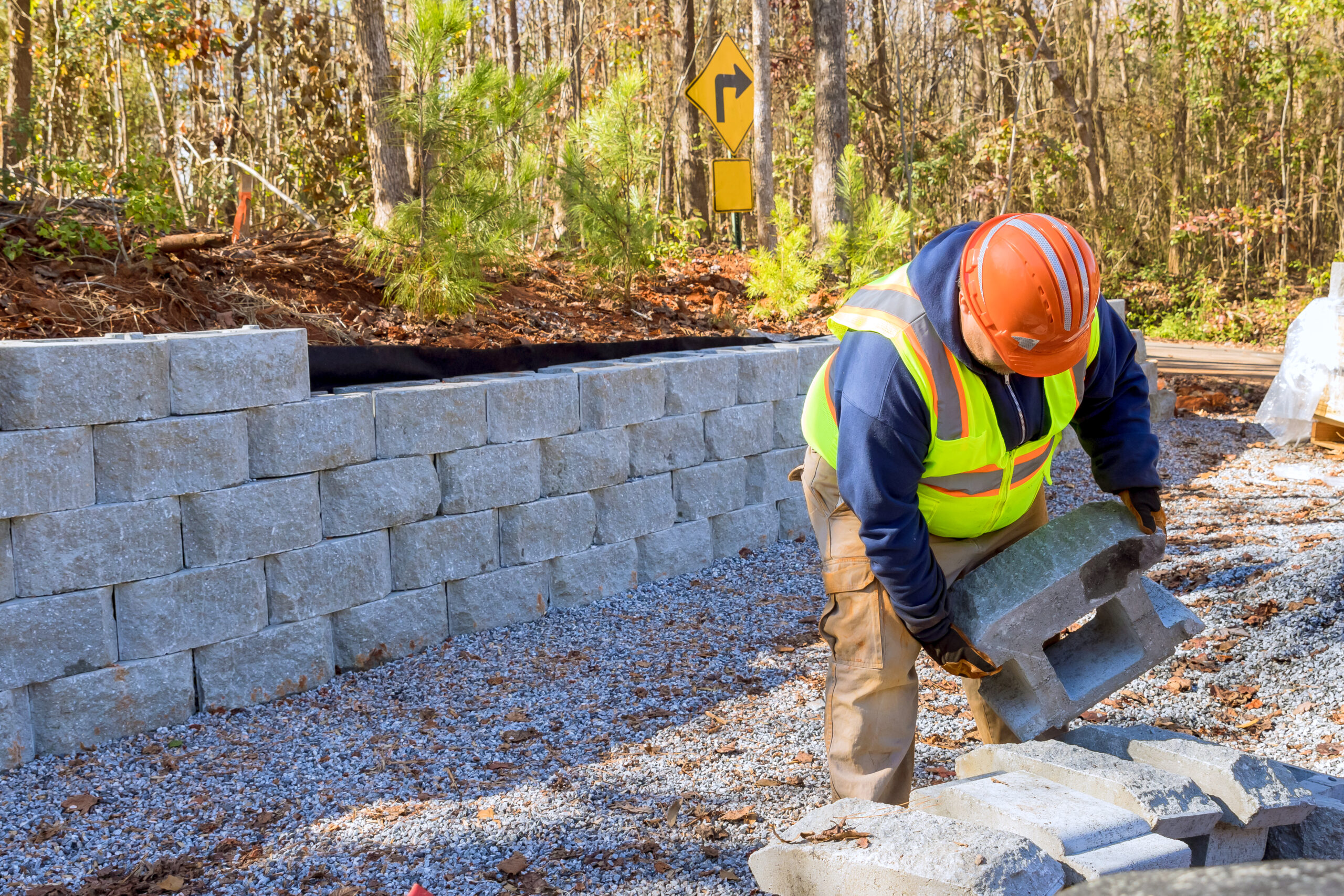Gardening is not just a hobby or profession; it’s an art that enhances the beauty and value of your home. Whether you’re a homeowner dreaming of a serene backyard, a garden enthusiast eager to create vibrant landscapes, a landscaping contractor bringing visions to life, or a DIYer ready for your next project, the aim is to craft an outdoor space that’s both beautiful and functional. Concrete blocks stand out as a versatile solution, offering endless possibilities to achieve your garden design goals.
In this article, we’ll explore five creative ways to use concrete blocks and bricks in your garden, showcasing how these simple materials can be transformed into functional and aesthetic elements. From durable garden pathways and robust retaining walls to unique outdoor furniture and decorative features, concrete blocks allow for innovation in garden design. They offer a sustainable, cost-effective approach without sacrificing style.
Join us as we dive into the potential of concrete blocks, demonstrating how they can elevate your garden from ordinary to extraordinary, blending practicality with creativity to reflect your style and vision.
Why Use Concrete Blocks?
Concrete blocks are highly regarded in garden design for their durability, cost-effectiveness, and aesthetic versatility. They stand up to weather and time, making them suitable for a variety of outdoor projects. Their affordability allows for wide-ranging use, from minor enhancements to major landscaping endeavours.
The variety in shapes, sizes, and colours of concrete blocks supports endless design creativity, enabling the realization of both modern and traditional garden aesthetics. This adaptability encourages experimentation with textures and patterns, leading to distinctive and appealing outdoor spaces.
Moreover, concrete blocks align with sustainable gardening practices. Constructed from natural materials, they are an eco-friendly option due to their recyclability, contributing to environmental conservation efforts. Their thermal mass properties also benefit plant growth by stabilizing temperature variations and enhancing the health and development of garden vegetation.
In essence, concrete blocks merge strength, economy, design flexibility, and eco-sustainability, making them a top choice for gardeners and landscapers aiming to create impactful and sustainable outdoor areas.
Creative Ways to Use Concrete Blocks
Below are five ways to creatively use your concrete blocks and bricks:
Garden Pathways
Concrete blocks offer a unique blend of durability and aesthetic appeal, making them an ideal choice for crafting visually striking garden pathways. By strategically arranging these blocks, you can transform a simple garden path into a standout feature of your outdoor space. The versatility of concrete blocks, available in an array of colours, shapes, and sizes, opens up a world of design possibilities. This variety enables you to tailor your pathway to fit the overall theme of your garden, whether you’re aiming for a sleek, modern look or a more rustic, traditional feel.
The creative potential of concrete blocks is immense. For instance, mixing different colours can create a vibrant mosaic effect, while varying sizes can be used to form intricate patterns or guide the flow of movement through your garden. Such design flexibility not only enhances the aesthetic appeal of your garden but also invites personal expression and creativity into the landscaping process.
Beyond their visual appeal, concrete block pathways offer significant practical benefits. They are remarkably easy to maintain, requiring little more than regular cleaning to keep them looking their best. Additionally, their robust construction ensures that they can withstand heavy foot traffic, making them a practical choice for both private gardens and public spaces. This durability means that your pathway will retain its beauty and functionality for years to come, with minimal upkeep.
Moreover, the installation of concrete block pathways can contribute to improved garden accessibility. By providing a stable and level surface, they make it easier to navigate the garden, enhancing the overall usability of the outdoor space. This is particularly beneficial in gardens that see a lot of use or those designed to be accessible to individuals with mobility challenges.
Concrete blocks, therefore, stand out as not merely a practical selection for crafting garden pathways due to their resilience and ease of upkeep. They also serve as a creative medium, enabling designers and homeowners alike to explore various configurations, hues, and dimensions to forge distinctive, aesthetically pleasing walkways. These pathways do more than just elevate the garden’s visual charm; they also enhance its functionality and accessibility, positioning concrete blocks as an exceptional option for landscaping endeavours.
Retaining Walls and Edging
Utilising concrete blocks to create retaining walls presents a robust and stylish solution for structuring garden beds and defining distinct areas within your outdoor space. These versatile building materials excel in forming clear boundaries between different sections of your garden, such as separating lush flower beds from vibrant vegetable patches or creating a dedicated herb garden area. The physical structure of retaining walls not only serves a functional purpose in preventing soil erosion and managing garden layout but also adds a layer of visual interest and depth to the landscape.
Concrete blocks are particularly advantageous for garden edging, offering a durable and aesthetically pleasing option to neatly border various garden sections. This not only helps in organising the garden space more effectively but also enhances the visual separation between different plantings, making each area stand out. The clean lines and structured appearance of concrete block edging can elevate the overall design of your garden, contributing to a more polished and cohesive look.
READ: Lawn Edging on a Budget: Affordable yet Attractive Solutions for Australian Gardens
One of the key benefits of using concrete blocks for these purposes is their ease of installation. Even those with minimal landscaping experience can successfully install concrete block retaining walls and edging, making it a practical DIY project that can significantly impact the garden’s appearance and functionality. Additionally, the modular nature of concrete blocks allows for flexibility in design, enabling you to create custom shapes and configurations that fit your garden’s unique dimensions and style.
Beyond their structural benefits, concrete blocks offer ample opportunity for customization. They can be painted or decorated to match or complement your garden’s overall aesthetic, allowing them to blend seamlessly with the surrounding environment or stand out as a feature element. Whether you prefer a natural, understated look or wish to introduce bold colours and patterns, concrete blocks can be adapted to suit your vision. This level of customisation not only enhances the garden’s visual appeal but also allows you to express your style through your outdoor space.
Incorporating concrete blocks into your garden design for retaining walls and edging not only improves the structural integrity and organization of your outdoor area but also opens up a world of creative possibilities. Their durability, ease of installation, and potential for customization make concrete blocks an excellent choice for gardeners and landscapers looking to enhance both the functionality and aesthetic appeal of their gardens.
Raised Plant Beds
Raised plant beds are a standout feature in any garden, offering both aesthetic appeal and practical gardening benefits. Concrete blocks, known for their durability and ease of assembly, are the ideal material for constructing these elevated beds. They allow for excellent drainage, ensuring that excess water is efficiently removed, preventing waterlogging and root rot. This feature is crucial for promoting healthy plant growth and robust root development.
The resilience of concrete blocks to various weather conditions makes them a fitting choice for the Australian climate, guaranteeing that your raised beds withstand the elements year-round. This durability translates into long-term savings, as there’s little need for ongoing maintenance or replacement.
Aesthetically, concrete block raised beds offer immense flexibility. Their modular design enables gardeners to experiment with different shapes and sizes, customizing their raised beds to suit the garden’s style. Whether aiming for a modern or rustic look, these blocks can be arranged and even painted or textured to achieve the desired appearance.
Moreover, these raised beds provide a solution to poor soil quality, allowing gardeners to fill them with a tailored soil mix. This is especially beneficial for cultivating plants with specific soil requirements, offering control over the growing environment that ground-level beds can’t match.
In essence, raised plant beds made from concrete blocks merge functionality with style, making them a smart and sustainable addition to gardens. They enhance drainage, withstand harsh weather, and offer customizable design options, making them invaluable for Australian gardeners
Outdoor Furniture
For those aiming to infuse their outdoor spaces with both uniqueness and functionality, creating furniture from concrete blocks is a compelling choice. This DIY approach allows for the crafting of benches and tables that blend the industrial appeal of concrete with the warmth of wooden slats or other materials, resulting in stylish and comfortable seating areas. Concrete block furniture is durable and weather-resistant, making it a practical option for any garden or patio setting.
The maintenance of concrete block furniture is minimal, requiring just a simple wipe-down to keep it looking its best. This ease of upkeep, combined with the material’s resistance to weathering, makes it an attractive choice for outdoor environments.
Customization is a key benefit of concrete block furniture; it can be painted or adorned to align with your garden’s aesthetic, offering endless possibilities for personalization. Adding wooden slats enhances the furniture’s comfort and visual appeal, and for an extra touch of coziness, cushions or outdoor fabrics can be incorporated.
Creating furniture from concrete blocks not only serves a practical purpose but also showcases a commitment to sustainability and creativity. This method allows for the upcycling of materials, contributing to a more sustainable lifestyle while enabling you to express your design flair.
In essence, concrete block furniture combines durability, low maintenance, and the ability to customize, making it an excellent addition to outdoor spaces. It offers a unique, comfortable, and durable solution for those looking to enhance their gardens or patios with furniture that reflects their style and stands the test of time.
Decorative Elements
Concrete blocks are a highly versatile medium for both functional planters and decorative garden art. Easily customizable to fit any garden theme, these blocks can be painted or adorned to transform into stylish planters perfect for a wide array of plants, from vibrant flowers to nutritious vegetables. This simplicity in creation and adaptability makes them a practical choice for gardeners looking to enhance their space’s visual appeal and biodiversity.
Moreover, concrete blocks open up creative avenues for crafting distinctive garden art, such as sculptures or fountains, infusing personal flair into outdoor areas. These elements not only serve as eye-catching focal points but also enrich the garden’s ambience, especially with water features like fountains that add a tranquil sound and movement to the setting.
Engaging in the creation of concrete block planters and art is a rewarding process that personalizes and elevates garden spaces. It’s an opportunity to experiment with design while adopting a sustainable approach to gardening by repurposing materials. Concrete blocks merge durability, functionality, and aesthetic versatility, offering gardeners a foundation for innovation in garden design. This approach enhances outdoor living areas, making them more inviting and reflective of individual creativity and style.
Installation Tips and Considerations
When incorporating concrete blocks into your garden design, ensuring proper installation is key to the success and longevity of your project. Here’s a detailed list to guide you through the process, ensuring that your concrete block installations are both beautiful and durable:
1. Site Preparation
- Clear the Area: Remove any debris, weeds, or existing structures from the site where you plan to install your concrete blocks.
- Level the Ground: Use a shovel and rake to level the ground. For projects requiring precise levelling, such as pathways or patios, consider using a spirit level.
2. Material Selection
- Choose the Right Blocks: Select concrete blocks that are appropriate for your project in terms of size, colour, and texture. Consider the aesthetic you wish to achieve in your garden.
- Climate Consideration: Opt for blocks that are suited to your local climate. In areas prone to freezing, ensure the blocks are frost-resistant to prevent cracking.
- Soil Compatibility: Choose blocks that work well with your soil type, especially if you’re building retaining walls or raised beds that interact directly with the soil.
3. Tools and Equipment
- Gather Necessary Tools: Depending on your project, you may need a shovel, spirit level, rubber mallet, chisel, and safety equipment.
- Safety Equipment: Always wear appropriate safety gear, including gloves, eye protection, and sturdy footwear, to protect yourself during the installation process.
4. Installation Techniques
- Dry Lay or Mortar: Decide whether your project requires mortar. Dry laying is suitable for many garden projects and allows for easier adjustments and drainage.
- Ensure Proper Alignment: Use a string line or chalk line to keep your blocks aligned. Check regularly with a spirit level to ensure everything is level and straight.
5. Drainage Considerations
- Plan for Water Runoff: Especially important for retaining walls and raised beds, ensure there’s a system in place for water to escape to prevent waterlogging.
6. Finishing Touches
- Seal if Necessary: Some projects, like patios or pathways, may benefit from sealing the blocks to protect against weathering and staining.
- Landscaping: Once your blocks are installed, consider the surrounding landscape. Planting around your new structures can help them blend into your garden and improve soil stability.
7. Maintenance
- Regular Checks: Periodically inspect your concrete block structures for any signs of movement or damage, especially after extreme weather conditions.
By following these steps and considerations, you can ensure that your concrete block installations not only enhance the beauty of your garden but also stand the test of time. Proper preparation, material selection, and installation techniques are crucial to achieving a successful outcome that complements the specific conditions of your outdoor space.
Final Thoughts
Concrete blocks offer a versatile and eco-friendly solution for enhancing garden designs, from pathways and retaining walls to outdoor furniture and decorative accents. By following proper installation techniques and considering your garden’s specific environmental needs, you can create a beautiful and enduring outdoor space.
We’re keen to hear your thoughts or questions on using concrete blocks in your garden projects. Feel free to share in the comments below. For more garden design inspiration and tips, consider subscribing to our blog and following us on social media. Let’s explore the potential of concrete blocks together, crafting sustainable and attractive gardens for years to enjoy.


